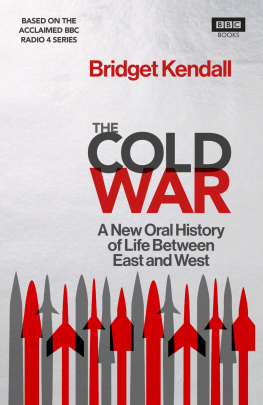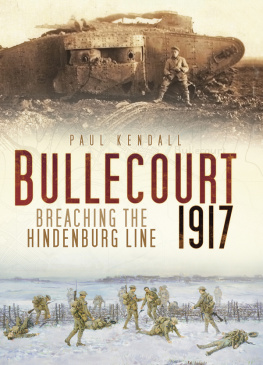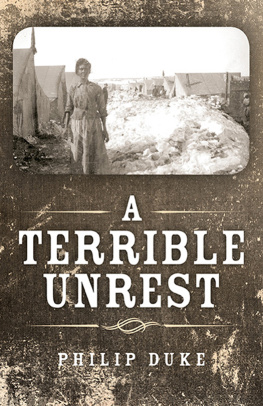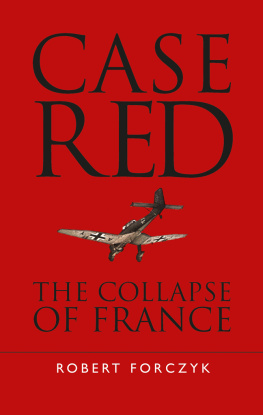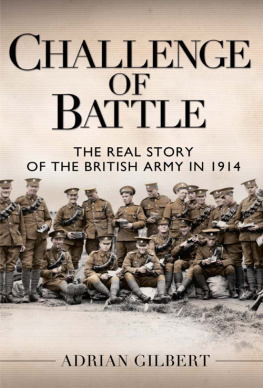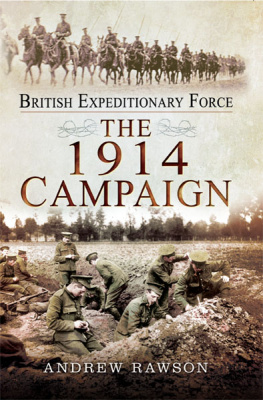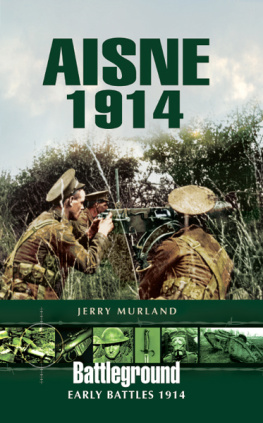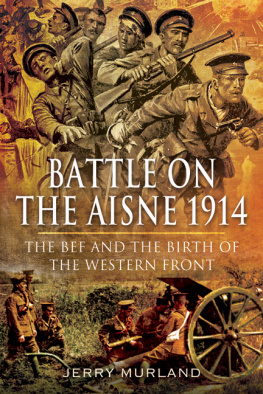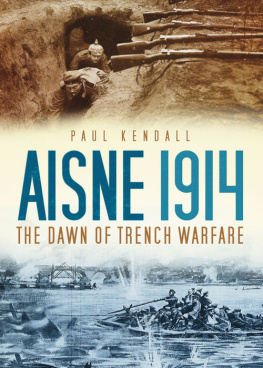
The author is always looking to gather more information about the Battle of the Aisne for revised editions of this volume. If you are related to any of the participants of the battle and have photographs, personal testimonies, letters, diaries or any relevant information, please contact Paul Kendall at paul.kendall193@btinternet.com.
This book is dedicated to my uncles Ted Whiley and John Whiley and to the Old Contemptibles who fought at the Battle of the Aisne in 1914.
It was in the fighting on that river that the eyes of all of us began to be opened.
Field Marshal Sir John French
The river is 50 yards wide and we had to cross on a single girder about 9 inches wide. It was a feat of tightrope that never fell to the lot of a British soldier before. The bullets were as numerous as hailstones and the shells, well, they defy description. The cries of the wounded who had been knocked off the girder and drowning enough to turn a mans brain.
Private Heys, 1st Kings (Liverpool) Regiment
The Victoria Cross is won over and over again in a single day. They are brave! What if you were to see how the wounded act after the excitement of battle! They suffer their wounds, great and small, without a murmur; they get their wounds dressed, take chloroform, give consent to have their limbs amputated, just as if they were going to have their hair cut. They are gloriously brave.
MO of the 14th Field Ambulance
CONTENTS
T his volume is the result of several years of research. I am indebted to many individuals without whose assistance producing such a work would be impossible. I would like to thank Yves Fohlen, battlefield guide, Caverne du Dragon Museum, for proofreading and for his continued friendship and support. I have known him as a friend for many years and I have spent time walking the Chemin des Dames with him. I value his guidance, knowledge and tutelage regarding the Aisne and all First World War subjects. Walking the Aisne battlefield with Yves was an awe-inspiring experience, to follow in the footsteps of the soldiers of the BEF brought home to me the enormity of their task to cross the Aisne and assault the ridge of the Chemin des Dames when they were totally exhausted and under constant, heavy enemy fire. Even today, the Chemin des Dames is a dangerous place to walk; there are wooded ridges, bluffs and spurs that conceal deep dugouts. I was glad to have Yves as my guide, who was able to show me these extraordinary places safely.
I would like to thank the Trustees of the Imperial War Museum, London, for permission to use material from the Department of Documents and Sound Collections, in particular Anthony Richards and Simon Offord at the IWM Department of Documents and Margaret Brooks from the IWM Sound Archives for assisting me in contacting copyright holders. Every effort has been made, but if anyone has not been credited the publishers apologise and will correct the omission on reprint.
I am grateful to Nicholas Coney at the National Archives for advising me on copyright and Judy Noakes of the Office of Public Sector Information for confirming copyright status of London Gazette material.
I thank Richard Davies at the Liddle Collection for assisting me in contacting copyright holders for the material within their archives and for arranging for transcripts of interviews to be sent to me.
I would like to thank Ann Dennison, Community History Manager, Preston District, Shona Milton, History Centre Officer, Brighton History Centre, John-Paul Carr, Northamptonshire Studies Manager, Gail Priddice at Inverness Library, Eileen Moran at Dundee Central Library, Edith Wemyss at Aberdeen Central Library, Nigel Lutt at the Bedfordshire and Luton Archives, Adrian Wilkinson at Lincolnshire Libraries, Gwilym Games, Local Studies Librarian at Swansea Library & Information Services and Mary Bradley of the Ballymena Library.
I extend my thanks to Pamela Clark, Registrar, Royal Archives, for allowing me to quote from a letter written by Field Marshal French to King George V.
The administrators of the website www.memoiredeshommes.sga.defense.gouv.fr kindly gave permission for reproduction of a map of Soupir.
I also thank Major W.H. White, DL at Cornwalls Regimental Museum, Thomas Smyth, archivist at The Black Watch Museum and for the Trustees of the Black Watch Museum, Mr I.G. Edwards from the Sherwood Foresters Museum, Colonel Seymour at the RHQ Grenadier Guards Archives, Major Robert de L. Cazenove at the RHQ Coldstream Guards Archives, Dominic Kearney at the RHQ Irish Guards Archives, Major Ken Gray (retd.) at the Royal Green Jackets Museum, Jane Davies, curator and Dorothy Williams, researcher, at the Museum of the Queens Lancashire Regiment, Terence Nelson, curator at the Royal Ulster Regiment Museum, Oliver Fallon, Chairman and archivist of the Connaught Rangers Association, Karen ORourke, Curator of Social History, National Museums Liverpool, Rachel Holmes at the Royal Hampshire Regiment Museum, Major (retd) J.H. Peters MBE at the Rifles (Berkshire & Wiltshire) Museum, Martin Everitt at the Museum of the Royal Welsh and Lauren Jones at the Royal Engineers Museum, Library and Archive. (We have had a debate as to how the Welsh Regiment, known as the Welch in the Great War and beyond, should be spelled in this book and were advised by a curator of the Royal Regiment of Wales that the spelling Welsh is more commonly used today, regardless of period. There is no easy answer and if anyone is offended by the adopted spelling we apologise.)
The reader will find short biographies and photographs of soldiers who fought at the Battle of the Aisne throughout this book. While it is perfectly possible to follow the narrative without reference to these, it is hoped that they will provide the reader the opportunity to take time to reflect upon their lives and their sacrifice. The short entries are intended to be a kind of wholly inadequate memorial to these men in themselves.
I am indebted to all the following relatives who have kindly provided photos and information, as well as giving their time to review the relevant draft pieces. I thank them for their generosity and for allowing me to pay homage to their brave forebears.
LANCE CORPORAL ALFRED ALDRIDGE , 2nd Royal Sussex Regiment: Neil Aldridge, (grandson).
PRIVATE JAMES BALLARD , 2nd Royal Sussex Regiment: Paul Ballard (grandson).
PRIVATE HERBERT BARKS , 1st Coldstream Guards: Trudie Brace (great granddaughter)
PRIVATE ERNEST BUCKLAND , 2nd Coldstream Guards and Private William Buckland 1st Coldstream Guards: Dick Monk (relative)
SERGEANT ARTHUR BURCHETT , 3rd Coldstream Guards: Keith Burchett (great nephew) and Debbie Jackson (great niece).
PRIVATE THOMAS CLULOW , 2nd South Lancashire Regiment: Steven Thompson (great grandson).
DRIVER THOMAS COFFIN , 11th Field Company, Royal Engineers: Kelly Howie (great niece)
PRIVATE WALLACE CLISSOLD , 2nd Grenadier Guards: Martin Clissold (great nephew).
PRIVATE HARRY DUNCOMBE , 3rd Coldstream Guards: Cynthia Bone (granddaughter). Derek Duncombe (nephew).
SAPPER ALBERT GUMM , At Cable Section, Royal Engineers: Brian Gumm (son).
CAPTAIN A.H. HABGOOD , 9th Field Ambulance: The Right Reverend Lord Habgood (son).
PRIVATE HEYS , 1st Kings Liverpool Regiment: Mrs S. Palin (granddaughter).
RIFLEMAN JOHN ILES , 2nd Kings Royal Rifles Corps: Keith Iles (grandson).
PRIVATE ERNEST KEATES , 2nd Royal Sussex Regiment: Mary Miles (great niece).
SERGEANT ARTHUR LANE , 2nd Coldstream Guards: Arthur Lane and Brian Lane (sons).
PRIVATE MICHAEL LEE , 1st Cameron Highlanders: Maureen McAuley (great niece).
SERGEANT WALTER LEDBURY , 1st Loyal North Lancashire Regiment: Shelia Linton (relative).
Next page


